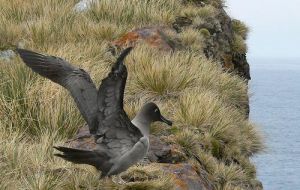MercoPress. South Atlantic News Agency
Sooty albatross set breeding record in South Shetland Islands
 The new colony is 1.520 kilometres from the nearest known breeding colony in South Georgia
The new colony is 1.520 kilometres from the nearest known breeding colony in South Georgia A small group of light-mantled sooty albatrosses has set a new breeding record. The birds have created a colony on King George Island, one of the South Shetland Islands located in Antarctica.
This new breeding colony is the southernmost breeding location of any albatross species ever recorded. Researchers spotted two confirmed nests on the island, one containing eggs and the other nestlings, and three more possible nests.
The light-mantled sooty albatross (Phoebetria palpebrata) is a medium-sized albatross that has a circumpolar distribution around the Southern Ocean.
It is the most abundant albatross in Antarctic waters and is known to range further south than other albatross species, often flying as far south as the border of the Antarctic pack ice during long-distance foraging trips.
However, it was only thought to nest on sub-Antarctic islands, lying at latitudes between 46 and 53 degrees South.
That was until Simeon Lisovski and Hans-Ulrich Peter of the Friedrich Schiller University of Jena, in Germany and colleagues Karel Weidinger and Vaclav Pavel of Palacky University in Olomouc, Czech Republic discovered a new breeding colony of the birds at Fildes Peninsula on King George Island, at latitude of 62 degrees and 12 minutes south.
In the summer season spanning 2008 and 2009, a research group led by Dr Peter saw light-mantled sooty albatrosses landing on a large 140m-high flat-topped rocky outcrop on the island.
“On Christmas day I got an unexpected call via the radio that two colleagues could observe some light-mantled sooty albatrosses landing on a very small jutty at the scarp of the rock,” says Lisovski.
So Lisovski, Weidinger and Pavel kept observing the birds, until in February this year they discovered adults at two nests. They also saw three more sitting adults, suggesting three further nests, though they couldn't climb the rocky outcrop to confirm this.
The new breeding colony is some 1,520km away from the nearest known breeding colony of light-mantled sooty albatrosses, which is on the island of South Georgia, the team reports in the journal Polar Biology.
It is unclear why the birds are breeding so far south.
Climate change could be creating warmer and more benign conditions for the birds, the researchers speculate, though it is not yet clear whether this is the case.
Whatever the cause, the birds are likely to have a much smaller breeding window in the Antarctic.
Light-mantled sooty albatross chicks need 70 days to hatch and another 70 to become independent. So even if they start nesting early in November, when there is no snow, the chicks will not be ready to fly until April, leaving them vulnerable to extreme weather events. (BBC).-




Top Comments
Disclaimer & comment rulesCommenting for this story is now closed.
If you have a Facebook account, become a fan and comment on our Facebook Page!